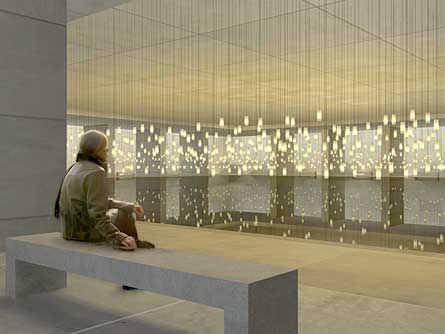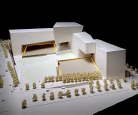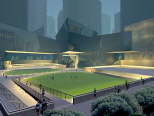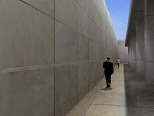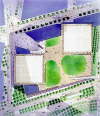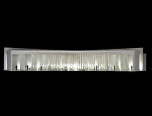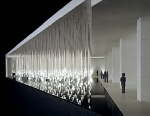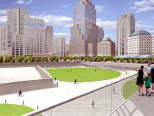|
Inversion of Light
Normand Lee and Michael Lewis, Houston, TX
In their absence, the World Trade Center Towers have attained a greater degree of symbolic significance, their
meaning instantaneously transformed on September 11, 2001. As monumental buildings, they were symbols of American capitalism, as voids, they now represent a concept of loss unparalleled in both scale and complexity.
Our proposal for the WTC memorial aims to transform the towers' footprints into dual sanctuary spaces that resonate profoundly with a sense of both individual and collective loss.
The memorial sanctuaries will be set into the earth and semi-enclosed from the outside. Only narrow gaps that outline each footprint will allow sunlight to penetrate into these sacred areas. Austere and minimal, the exteriors
will give no indication of their interior space. From street level, the sanctuaries' monolithic expanses will invite contemplation and suggest absence.
Once on the memorial grounds, the sanctuaries will only be made visible to visitors by long parapet walls that surround the footprints of the original towers. Most of this area will be kept as green park space providing a
versatile venue for memorial ceremonies. Visitors will also be visually drawn to the exposed slurry walls on the western edge of the site as well as the Liberty Wall located on the southern side. The Liberty Wall will be
engraved with monumental text that provides a didactic historical timeline of the World Trade Center site. A large part of this story will focus on the heroic efforts of brave rescue workers who worked tirelessly, many of
who made the ultimate sacrifice, to save lives on September 11th.
Visitors will descend down a stairway or lift system into each sanctuary, emerging into a darkened, serene
environment. Here they will witness an expansive field of votive lights suspended in mid-air creating a sublimely beautiful downpour of loss. The votives, each representing a victim of the terrorist attacks, hang down on
cables from the sanctuary ceiling just above a reflecting pool. The cables will function as capillaries that channel
liquid fuel into the votives to sustain the symbolic flames. The age of each victim is used to determine the height
of the suspended votives creating an irregular field of light that both breaks apart into fragments and coalesces as an entirety. This reinforces the memorial mission to convey both the overall magnitude of loss and pay
tribute to individual lives. As a part of the memorial's creation, victims' families and friends will be invited to light
the votives that represent their lost loved ones. Each flame, therefore, will be created by an individual act of remembrance.
The name of each victim will be listed horizontally in alphabetical order on the parapet walls that define and encompass each sanctuary space. The procession of names will begin in the sanctuary devoted to the North
Tower, where the first plane hit, and conclude in the sanctuary dedicated to the South Tower. A somber underground passageway will connect these two sanctuaries as well as provide access to a burial space
located at bedrock for the unidentified remains of victims.
Norman Lee
Norman Lee graduated with a BA in Psychology from the University of Texas at Austin and a BA in Art History
from the University of Houston. In 1997, Lee received an internship with Walt Disney Imagineering, developing attraction concepts for Disney's California Adventure theme park. Lee continued his studies at the University of
Texas, where in 2000 he received a MA in Museum Education. The topic of his thesis examined the contribution that museum exhibit professionals make toward implementing education and entertainment in
creating enriched experiences for museum visitors. He currently works as a senior concept developer of museum exhibits in Houston, Texas, the city where he was born and raised.
Michael Lewis
Michael Lewis graduated with a BA of Theater Arts (Design and Technical Directing emphasis) from
Presbyterian College, Clinton, South Carolina. During that time he studied Photography in Oxford, England, as well as Film Directing through a joint studies program with the New York Film Academy. He has worked as a
technical director for theater and television and convention centers, and as a resident set and lighting designer for various stage productions. He currently works as a Museum Exhibit Designer and Project Manager on
large-scale museum installations. Born in Memphis, Tennessee, Mr. Lewis currently resides in Houston, Texas.
Acknowledgements:
Scale Models: Richard Coleman Associates - Houston, TX
Illustrations/animation by Payne Rowlett - Houston, TX
Plan and Section Drawings: Jim Arp Architectural Renderings - Houston, TX |
|


